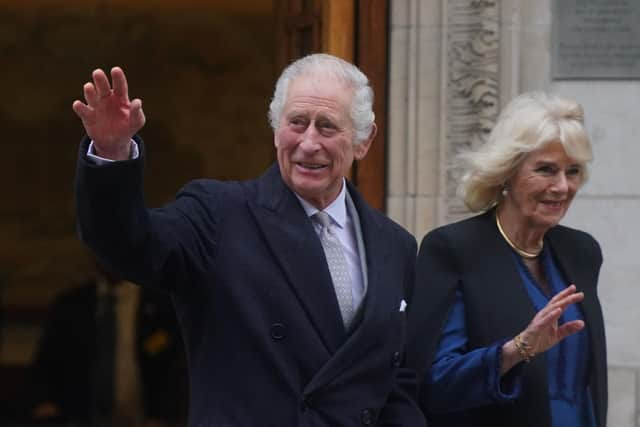King leaves hospital after prostate treatment: Charles will now have 'period of private recuperation' says Buckingham Palace
and live on Freeview channel 276
Charles, 75, smiled and waved to a few members of the public as he left the private London Clinic on Monday afternoon with the Queen by his side, and would now have a “period of private recuperation”, Buckingham Palace said.
Camilla had arrived at the hospital ahead of the King being discharged, and had visited her husband every day since he was admitted on Friday.
Advertisement
Hide AdAdvertisement
Hide AdBuckingham Palace said in a statement: “The King was this afternoon discharged from hospital following planned medical treatment and has rescheduled forthcoming public engagements to allow for a period of private recuperation.
“His Majesty would like to thank the medical team and all those involved in supporting his hospital visit, and is grateful for all the kind messages he has received in recent days.”
The King underwent a corrective procedure for the benign condition and it has been reported Charles could take up to a month off from public duties as he recuperates.
He left the London Clinic a few hours after the Princess of Wales was discharged from the same hospital, almost two weeks after undergoing abdominal surgery.
Advertisement
Hide AdAdvertisement
Hide AdCharles spent time at his daughter-in-law’s bedside before his own treatment; Kate is not expected to return to official duties until after Easter.


The King was diagnosed with the benign condition on January 17 while staying at Birkhall in Scotland, after going for a check-up because he was experiencing symptoms.
He is understood to have wanted to share the news to encourage other men to get themselves checked.
The King, who acceded to the throne 16 months ago, was urged to rest by his doctors ahead of the corrective procedure.
Advertisement
Hide AdAdvertisement
Hide AdNHS England said the “enlarged prostate” page on the NHS website received one visit every five seconds on the day the King’s diagnosis was announced, with further huge boosts in visits in the days that followed.


Buckingham Palace has said the King was “delighted” to learn his diagnosis was having a “positive impact on public health awareness”.
One in three men over the age of 50 will have symptoms of an enlarged prostate, including needing to visit the toilet more often and with more urgency and difficulty emptying the bladder.
An enlarged prostate, known as benign prostatic hyperplasia, does not usually pose a serious threat to health and it is not cancer.
Advertisement
Hide AdAdvertisement
Hide AdBut patients may need to have several tests for the condition to rule out the possibility they have another illness with similar symptoms, such as prostate cancer.
Surgery is usually only recommended for moderate to severe symptoms which have not responded to medicine, the NHS website says.
Treatment can include a number of procedures, including removing part of the prostate gland with a laser, water ablation using the pressure of the water to destroy prostate tissue, or urethral lift implants, which hold the enlarged prostate away from the urethra so it is not blocked.
Other options include a prostate artery embolisation, during which tiny plastic particles are injected into blood vessels to shrink the prostate gland by reducing its blood supply.